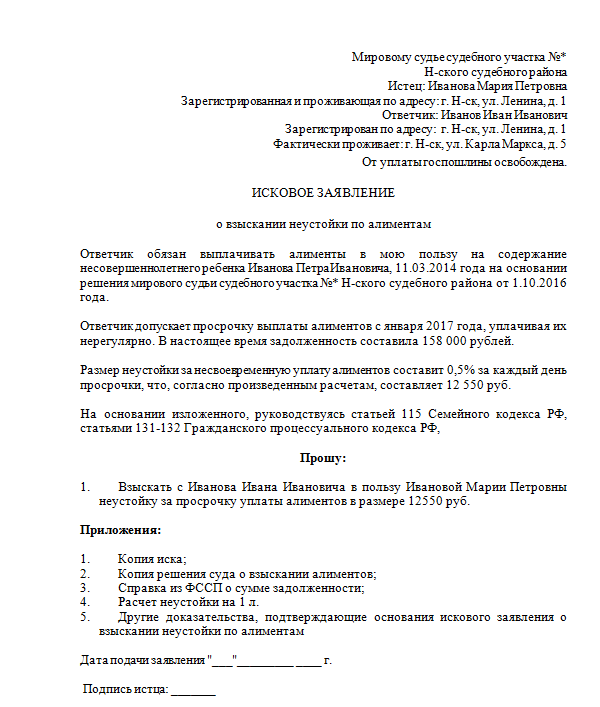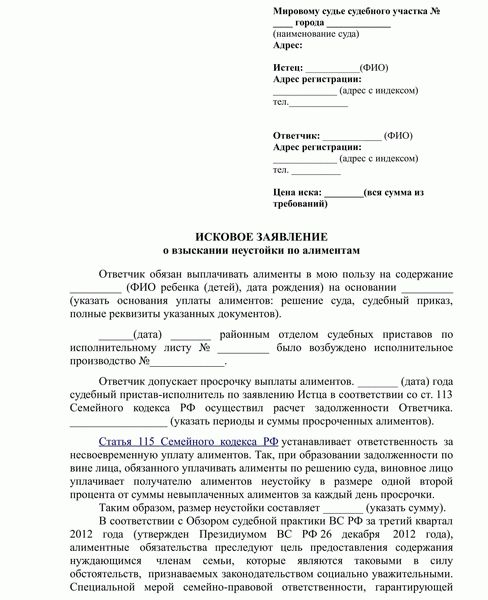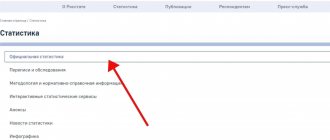3
Child support is the amount that a parent is required to pay to provide for their minor child. In this case, the payer can be either a parent who left the family or actually lives with the child, but evades fulfilling his parental responsibilities.
IMPORTANT: In addition to forced collection, a citizen can pay alimony voluntarily by concluding an agreement on the payment of alimony with the second parent. If a lawsuit was filed to recover alimony payments, the parent will have to pay alimony by court decision
.
However, not every parent conscientiously fulfills the terms of the agreement or court decision and pays child support on time. As a result, the debt accumulates, and the second parent has the opportunity to also collect a penalty for the amount of unpaid alimony.
In what cases is alimony penalty considered?
In accordance with the Family Code, the alimony payer must transfer funds for the maintenance of a minor child on a monthly basis. If, due to the fault of the payer, the child does not receive such payments, then the recipient of alimony (the parent with whom the child lives or guardian) can recover from the unscrupulous parent the arrears of alimony and the amount of the penalty.
Please note: All losses associated with late payment of alimony that were not covered by the penalty are also subject to recovery. But they will need to be proven in court.
Collection of penalties is an effective method of dealing with defaulters, but only if they have a constant source of income to pay the debt. Judicial practice shows that decisions are made in favor of the recipient of alimony, since the law fully protects the interests of children.
Consideration of the case
After receiving the application, the judge reviews it and schedules a hearing, of which the parties will be notified.
During the trial, the party filing the claim must substantiate its claim and present evidence. Both parties are given the right to prove their arguments. If the defendant does not agree with the plaintiff’s demands, he can present to the court evidence that he is not guilty.
This is interesting: When to transfer alimony from vacation pay
After hearing all parties and examining all documents, the court may make the following decisions:
- All points of the request will be fulfilled.
- The presiding officer will order payment of only part of the debt.
- The court will refuse to consider the application.
The decision made by the court may be appealed by the parties in accordance with the procedure established by law.
If the defendant does not agree with the amount of the penalty, he can challenge it and reduce the amount that must be paid. To do this, he needs to prove that the non-payment was not entirely his fault. Failure to contest or contest one's innocence may be an additional reason to collect the entire penalty.
After the presiding judge makes a decision to claim a penalty, the writ of execution drawn up on the basis of the decision is transferred to the bailiff service. And after that, the bailiffs deal with the issue.
Thus, if a debt arises due to the fault of the father, who must transfer money, the mother can demand, with the help of the court, to pay not only the entire debt, but also the entire penalty. As approved by the legislator, the amount of the daily penalty is equal to half a percent for each day.
A citizen who receives alimony may demand compensation for all expenses that occurred due to late payment or lack of payment at all.
From all of the above, the only conclusion is that it is better for the person obliged to pay alimony to pay on time.
Otherwise, the recipient has the right to file a claim in court and demand compensation:
- the entire amount of unpaid alimony;
- penalty for each day of delay;
- compensate for damage caused by non-payment of funds for the child’s subsistence.
The recipient of alimony simply needs to prove late payment or non-payment, which is not very difficult, and file a claim in court, and if the payer cannot prove his innocence, there is a high probability that the court will grant the plaintiff’s request.
Types of penalties
The law provides for two types of penalties for alimony payments:
- Legal penalty. According to the RF IC, the amount of this penalty is 0.5% of the amount of unpaid alimony and is calculated for each day of delay.
- Penalty by agreement. Applies if parents enter into an agreement to pay child support. In the agreement, the parties can stipulate the amount of the penalty in case of violation of obligations by the alimony payer (including violation of payment terms). Any amount of the penalty can be specified by agreement of the parties.
IMPORTANT: If the agreement does not indicate the amount of the penalty, then the penalty by law cannot be applied to legal relations under the agreement.
The penalty begins to accrue from the last day when the person had to fulfill the obligation and continues to apply until they are fully repaid.
How to fill out an application correctly
Collection of alimony debts and penalties is carried out through the court by filing an appropriate statement of claim. In principle, the applicant can draw up a claim on his own, using a sample from the Internet as a basis, but since each situation is individual, legal assistance from a specialist may be required.
Our lawyers are ready right now and completely free to advise you on filing a claim for the recovery of a penalty for alimony payments.
Form and content
There is no strictly established form of claim. However, there are some requirements for drawing up this document that must be followed so that the claim is not returned to the applicant.
The main provisions and content of a standard claim are set out in Art. 131 Code of Civil Procedure of the Russian Federation, in Art. 132 of the Code of Civil Procedure of the Russian Federation lists the requirements for the attached documents.
The structure of the claim is as follows:
- Name of the court, address;
- Details of the plaintiff and defendant (full name, residential address, contact details);
- Amount of claim, indication of exemption from state duty;
- Descriptive part (description of the current circumstances of the case, calculation of the amount of the claim (debt, penalties);
- Grounds of claim (indication of legal acts confirming the plaintiff’s claims);
- The pleading part (the plaintiff’s demand for restoration of violated rights);
- List of attached documents;
- Date of filing the claim and signature of the applicant.
Important: The statement of claim is submitted in 2 copies, since the second copy must be sent by the defendant. Also, copies of documents to be sent to the defendant must be attached in duplicate.
Sample application for collection of alimony penalties
The presented sample does not contain a calculation of the penalty, which should preferably be drawn up on a separate sheet with a step-by-step indication of the debt for each period of delay.

Where to file a claim for the recovery of alimony penalties?

An application for the collection of alimony penalties, a sample of which is available from the bailiffs, is submitted to the court. Before this, you need to contact the executive service so that the state executive can issue you a certificate indicating from what period and to what extent alimony was paid or not paid, and also calculates the amount of debt. If there is an agreement, the recipient of alimony can go straight to court. The plaintiff can calculate the amount of the debt himself, because the sanctions are specified in the agreement itself.
A penalty can only be collected in court; the executive service only oversees the process of paying alimony, but cannot impose penalties on a person.
If the sample application for alimony penalty was drawn up correctly, and the calculation of the penalty was carried out correctly, on a legal basis, the judge registers the application and begins the lawsuit. You will be notified by letter that your claim has been taken into account and court proceedings have been opened, and the date of the first court hearing will also be indicated there.
This is interesting: How much child support should a father pay?
Where to file a claim?
A claim for collection of alimony debt and penalties is filed with the magistrate who made the decision to collect alimony or at the place of residence of the defendant.
The plaintiff must send an application to the authority at the defendant’s place of residence in accordance with Art. 28 Code of Civil Procedure of the Russian Federation.
As a general rule, the magistrate considers claims whose amount does not exceed 50 thousand rubles. If the cost of the claim is greater than this amount, then the case will not be considered in the city or district court - the amount of the claim does not matter when collecting alimony.
Drawing up a petition
So, only the court considers a request for payment of a penalty. Here it is important to determine which court you will need to go to. This is easy to do: the choice depends on the size of the debt. If the amount does not exceed fifty thousand or is equal to this amount, then the magistrate will decide the issue. If the alimony provider is very arrogant and has not paid for a very long time, then only the federal court will help.
But before you apply, you need to correctly and competently draw up the petition itself and attach the necessary documents to it.
The court will not consider the issue if a whole bunch of unnecessary papers are attached to the application.
So, in the petition you need to indicate the following information:
- The name of the court, depending on the jurisdiction, is the magistrates' court or the federal district court.
- Passport information of the plaintiff indicating his telephone number.
- Passport information of the defendant indicating his telephone number.
- The plaintiff must state the essence of his demands and arguments why he believes that he has the right to collect the delay, and provide evidence of his arguments. Facts confirming the veracity of the information are attached to the application.
- An appeal to the court with a request, on the basis of the above, to force the alimony provider to pay the penalty and the alimony that he is overdue.
- The date and signature must be placed at the end of the document.
- Also make an inventory of the papers that are attached to the petition.
The application and attached documents, evidentiary materials, all together must be sealed and sent to the court.
If the plaintiff himself is not a legally savvy person, it makes sense to contact a lawyer, since you need to:
- draw up a petition to the court in a legally competent and correct manner;
- determine the cost of the claim;
- calculate the exact amount of the penalty.
This is interesting: Sample court order for the collection of alimony
To calculate the amount of payment, it is better to contact a bailiff, so they use certain formulas to derive the amount and certify it with their signature.
Attached documents
When going to court to file a claim, you will need to collect some documents confirming the stated circumstances.
You will need:
- Plaintiff's passports;
- Defendant's passport (if available);
- Child's birth certificate;
- Agreement on payment of alimony or a copy of the court decision;
- Receipts of the last payment received;
- A certificate from their FSSP about the amount of debt;
- Power of attorney to represent interests (if the claim is filed by an authorized person).
Copies of these documents are a mandatory attachment to the statement of claim. Without them, the court will not be able to consider the case.
Drawing up a statement of claim for the recovery of alimony penalties

A statement of claim for alimony penalties must be filed in the name of the magistrate, who will hear the case at the applicant’s place of residence. It will be interesting to know that a statement of claim for the recovery of a penalty for alimony arrears is subject to a state duty; it is calculated depending on the amount of recovery required by the applicant.
If the amount of the penalty greatly exceeds the limits of what is reasonable, then the defendant, the alimony payer, has the right to petition for amendments to the claim. In accordance with Article 333 of the Civil Code of the Russian Federation, the defendant may request a reduction in the amount of penalties. You can collect alimony only for three years from the date of the first non-payment; this type of claim has a statute of limitations.
It should be noted that if the collection of alimony was not carried out for a certain time due to the fact that the recipient of the alimony, having received a writ of execution or a court order, for some reason did not contact the enforcement service and did not begin enforcement proceedings. In this case, he cannot file a claim for the recovery of alimony penalties. The only thing he can count on is the payment of the amount of alimony itself; no fines or penalties will be charged.
The recipient must draw up a statement of claim for the collection of arrears of alimony and penalties on his own initiative, and the bailiff must help him with this. The claim must necessarily be supplemented by a calculation of the penalty, the calculation principle is known to the state executor, since there is an approved formula.
In order to file an application for alimony penalties, the claimant must know exactly what he has the legal right to do so. That is, there are grounds for this, so that it does not turn out that a person spent money on the state duty, lost time calculating the penalty, but cannot collect it according to the law. Deliberate evasion of alimony payments is confirmed by the following facts:
- debt formation for at least 3 months of non-payment;
- lack of contact between the debtor and the collector or bailiff;
- failure to respond to calls, summonses for appointments;
- change of place of residence or place of work and failure to notify the bailiff, the recipient of the funds;
- concealment of current income;
- dismissal from your last job at your own request, despite the existence of a child support obligation;
- deliberate non-employment and failure to register with the employment center.
If the above factors occur, then the guilt of the alimony provider will be proven, and you can sue. The application must be supported by certain documents; the list of required papers includes:
- applicant's passport (copy);
- child's birth certificate (copy);
- court decision (copy);
- divorce certificate or paternity certificate;
- if there is an agreement, then a copy of it will also be needed;
- original resolution on debt settlement (issued by a bailiff);
- calculation of penalties.
After all the documents have been collected and submitted to the court, all you have to do is wait for the call to the meeting. In order to avoid mistakes when drawing up a claim, you need to study in detail the sample application for the collection of alimony penalties, and it is even better if a competent lawyer or the bailiff himself draws it up for you.
State duty
Many citizens are interested in how much the procedure for collecting alimony penalties will cost.
Collection of penalties for late payment of alimony is one of the ways to protect the rights and interests of minor children. Plaintiffs in cases of protection of the rights of minors are exempt from paying state fees when filing a claim. This norm is provided for in paragraph 15, paragraph 1 of Art. 333.36 Tax Code of the Russian Federation.
As a general rule, the state fee for filing an application for alimony is 150 rubles, but since the plaintiff does not pay it upon application, this amount will be recovered from the defendant based on the results of the consideration of the case.
Sample statement of claim for the recovery of alimony penalties

The sample claim for the recovery of alimony penalties is the same. Its structure is clearly approved and must be strictly followed. A sample claim for filing in court is as follows:
- Heading - written on the right side of the sheet, must contain the name of the judge or the name of the court where the case is being heard. The header must contain information about the plaintiff, name and address, and the debtor must also be identified.
- The title of the document is in the center of the page.
- The main part is indicated here in a condensed form:
- when, by the decision of which court, from whom and in relation to whom, alimony was collected;
- method of collecting alimony;
- the month from which the delinquency began, and you must indicate the entire period of the debt;
- detailed calculation of the penalty.
- Claims usually begin with the word “please”. Here you can indicate not only the requirements that the alimony provider pay the penalty, but also that he return the state fee paid by the plaintiff for the application.
- List of attached documents.
- Date of filing the claim and signature.
The application form can be taken in person to the court office and registered or sent by mail.
In addition to paying alimony and penalties, if the prosecutor notices a crime in the actions of the alimony provider, he may also be subject to administrative penalties in the form of deprivation of the right to drive a car or even criminal liability if the alimony provider hid his current income and carried out various types of fraud.
Recently, the issue of alimony payments has received a lot of attention; this is not strange in principle, since the state always defends the interests of minor citizens. That is why it is better not to delay the payment of alimony if you do not want to face huge sanctions that are several times higher than the monthly payment.







